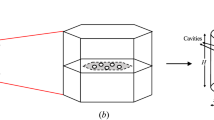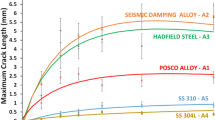Abstract
The formability can be improved in warm/hot sheet hydroforming due to two important factors of temperature and through thickness normal stress. An extension of the M-K model was presented in this paper with the liquid pressure induced through thickness normal stress taken into account. The through thickness normal stress was introduced by using the general form of the Hill48 criterion. The combined effect of temperature and through thickness normal stress on the increase of FLD0 is achieved by applying a proposed temperature dependent constitutive equation for 5A06 aluminum alloy (a Chinese designation of Al-Mg alloy, corresponding to the ASTM designation of 5056 aluminum alloy) into the M-K approach. The Newton–Raphson method is used in the numerical procedure and it is proved to be stable and correct. The yield loci show a significant dependence on temperature and through thickness normal stress. Both size shrinking caused by the elevated temperature and location shifting due to the increasing thickness normal stress of the yield loci are observed. Comparison of the experimental FLDs of AISI-1012 low carbon steel (an AISI designation of steel) at plane stress and room temperature, STKM-11A steel (a Japanese designation of Steel Tube Kozo Machine) for tube hydroforming at room temperature and 5A90 aluminum alloy (a Chinese designation of Al-Li alloy) at plane stress and elevated temperature with the theoretical results show good agreements. The effect of key parameters, such as inhomogeneity factor f 0, n value, m value and initial thickness T 0, grain size d, initial surface roughness R 0, show a strong dependence on FLDs and increase of FLD0. The increase of FLD0 is formulized in a full quadratic form, which is a function of temperature and through thickness normal stress. The left quadrant of FLD was determined by the cylindrical warm hydromechanical cup deep drawing, which shows a good accordance with the predicted results by using the modified M-K model.











Similar content being viewed by others
References
Keeler SP (1969) Circular grid systems: A valuable aid for evaluation sheet forming. Sheet Met Ind 45:633–640
Goodwin GM (1968) Application of strain analysis to sheet-metal-forming problems in the press shop. Metall Ital 60(8):767–774
Marciniak Z, Kuczyński K (1967) Limit strains in the processes of stretch-forming sheet metal. Int J Mech Sci 9:609–620. doi:10.1016/0020-7403(67)90066-5
Keeler SP, Backofen WA (1963) Plastic instability and fracture in sheets stretched over rigid punches. ASM TRANS Q 56(1):25–48
Hutchinson JW, Neale KW (1979) Sheet necking-II time-independent behavior. Mech Sheet Metal Form pp 127–153
Sowerby R, Duncan JL (1971) Failure in sheet metal in biaxial tension. Int J Mech Sci 13(3):217–229. doi:10.1016/0020-7403(71)90004-X
Hill R (1948) A theory of the yielding and plastic flow of anisotropic metals. Royal Society of London Proceedings Series A 193:281–297. doi:10.1098/rspa.1948.0045
Parmar A, Mellor PB (1980) Growth of voids in biaxial stress fields. Int J Mech Sci 22(3):133–150. doi:10.1016/0020-7403(80)90063-6
Hill R (1979) Theoretical plasticity of textured aggregates. Math Proc Cambridge Philos Soc 85:179–191. doi:10.1017/S0305004100055596
Lian J, Barlat F, Baudelet B (1989) Plastic behaviour and stretchability of sheet metals. Part II: Effect of yield surface shape on sheet forming limit. Int J Plast 5(2):131–147
Xu S, Weinmann KJ (1998) Prediction of forming limit curves of sheet metals using Hill’s 1993 user-friendly yield criterion of anisotropic materials. Int J Mech Sci 40(9):913–925
Hill R (1993) A user-friendly theory of orthotropic plasticity in sheet metals. Int J Mech Sci 35(1):19–25. doi:10.1016/0020-7403(93)90061-X
Kuroda M, Tvergaard V (2000) Forming limit diagrams for anisotropic metal sheets with different yield criteria. Int J Solids Struct 37(37):5037–5059
Cao J, Yao H, Karafillis A (2000) Boyce M C (2000) Prediction of localized thinning in sheet metal using a general anisotropic yield criterion. Int J Plast 16:1105–1129
Karafillis AP, Boyce MC (1993) A general anisotropic yield criterion using bounds and a transformation weighting tensor. J Mech Phys Solids 41(12):1859–1886
Butuc MC, Banabic D, Barata da Rocha A et al (2002) The performance of Yld96 and BBC2000 yield functions in forming limit prediction. J Mater Process Technol 125–126:281–286
Swift H (1952) Plastic instability under plane stress. J Mech Phys Solids 1:1–18
Voce E (1948) The relationship between stress and strain for homogeneous deformation. J Inst Met 74:537–562
Avila AF, Vieira EL (2003) Proposing a better forming limit diagram prediction: a comparative study. J Mater Process Technol 141(1):101–108
Hosford WF (1972) A Generalized Isotropic Yield Criterion. J Appl Mech 39:607–609
Graf A, Hosford WF (1990) Calculations of forming limit diagrams. Metall Trans 21A:87–94
Ganjiani M, Assempour A (2007) An improved analytical approach for determination of forming limit diagrams considering the effects of yield functions. J Mater Process Technol 182(1):598–607. doi:10.1016/j.jmatprotec.2006.09.025
Lee W, Chung KH, Kim D et al (2009) Experimental and numerical study on formability of friction stir welded TWB sheets based on hemispherical dome stretch tests. Int J Plast 25(9):1626–1654. doi:10.1016/j.ijplas.2008.08.005
Barlat F, Brem JC, Yoon JW et al (2003) Plane stress yield function for aluminum alloy sheets—part 1: Theory. Int J Plast 19:1297–1319. doi:10.1016/S0749-6419(02)00019-0
Cazacu O, Plunkett B, Barlat F (2006) Orthotropic yield criterion for hexagonal closed packed metals. Int J Plast 22:1171–1194. doi:10.1016/j.ijplas.2005.06.001
Soare SC (2010) Theoretical considerations upon the MK model for limit strains prediction: The plane strain case, strain-rate effects, yield surface influence, and material heterogeneity. Eur J Mech A-Solids 29(6):938–950. doi:10.1016/j.euromechsol.2010.05.008
Peirs J, Verleysen P, Van Paepegem W, Degrieck J (2011) Determining the stress–strain behaviour at large strains from high strain rate tensile and shear experiments. Int J Impact Eng 38(5):406–415. doi:10.1016/j.ijimpeng.2011.01.004
Johnson GR, Cook WH (1983) A constitutive model and data for metals subjected to large strains, high strain rates and high temperatures. Proc 7th Int Symp on Ballistics 21:541–547
Huang HM, Pan J, Tang SC (2000) Failure prediction in anisotropic sheet metals under forming operations with consideration of rotating principal stretch directions. Int J Plast 16(6):611–633. doi:10.1016/S0749-6419(99)00066-2
Chien WY, Pan J, Tang SC (2004) A combined necking and shear localization analysis for aluminum sheets under biaxial stretching conditions. Int J Plast 20(11):1953–1981
Zhou Y, Neale KW (1995) Predictions of forming limit diagrams using a rate-sensitive crystal plasticity model. Int J Mech Sci 37(1):1–20. doi:10.1016/0020-7403(94)00052-L
Signorelli JW, Bertinetti MA, Turner PA (2009) Predictions of forming limit diagrams using a rate-dependent polycrystal self-consistent plasticity model. Int J Plast 25(1):1–25
Serenelli MJ, Bertinetti MA, Signorelli JW (2011) Study of limit strains for FCC and BCC sheet metal using polycrystal plasticity. Int J Solids Struct 48(7):1109–1119
John Neil C, Agnew SR (2009) Crystal plasticity-based forming limit prediction for non-cubic metals: application to Mg alloy AZ31B. Int J Plast 25(3):379–398
Wang H, Wu PD, Boyle KP, Neale KW (2011) On crystal plasticity formability analysis for magnesium alloy sheets. Int J Solids Struct 48(6):1000–1010. doi:10.1016/j.ijsolstr.2010.12.004
Naka T, Torikai G, Hino R, Yoshida F (2001) The effects of temperature and forming speed on the forming limit diagram for type 5083 aluminum–magnesium alloy sheet. J Mater Process Technol 113(1–3):648–653. doi:10.1016/S0924-0136(01)00650-1
Abedrabbo N, Pourboghrat F, Carsley J (2006) Forming of aluminum alloys at elevated temperatures-Part 2: Numerical modeling and experimental verification. Int J Plast 22(2):342–373. doi:10.1016/j.ijplas.2005.03.006
Barlat F, Maeda Y, Chung K et al (1997) Yield function development for aluminum alloy sheets. J Mech Phys Solids 45(11):1727–1763. doi:10.1016/S0022-5096(97)00034-3
Abedrabbo N, Pourboghrat F, Carsley J (2006) Forming of aluminum alloys at elevated temperatures-Part 1: Material characterization. Int J Plast 22(2):314–341
Abedrabbo N, Pourboghrat F, Carsley J (2007) Forming of AA5182-O and AA5754-O at elevated temperatures using coupled thermo-mechanical finite element models. Int J Plast 23(5):841–875. doi:10.1016/j.ijplas.2006.10.005
Min J, Lin J, Li J, Bao W (2010) Investigation on hot forming limits of high strength steel 22MnB5. Comp Mater Sci 49(2):326–332. doi:10.1016/j.commatsci.2010.05.018
Stören S, Rice JR (1975) Localized necking in thin sheets. J Mech Phys Solids 23(6):421–441. doi:10.1016/0022-5096(75)90004-6
Gotoh M, Chung T, Iwata N (1995) Effect of out-of-plane stress on the forming limit strain of sheet metals. JSME Int J Ser A 38(1):123–132
Smith LM, Averill RC, Lucas JP, Stoughton TB, Matin PH (2003) Influence of transverse normal stress on sheet metal formability. Int J Plast 19(10):1567–1583
Stoughton TB (2000) A general forming limit criterion for sheet metal forming. Int J Mech Sci 42(1):1–27
Allwood JM, Shouler DR (2009) Generalised forming limit diagrams showing increased forming limits with non-planar stress states. Int J Plast 25(7):1207–1230
Banabic D, Soare S (2008) On the effect of the normal pressure upon the forming limit strains. Proceedings of NUMISHEET pp 199–204
Assempour A, Nejadkhaki HK, Hashemi R (2010) Forming limit diagrams with the existence of through-thickness normal stress. Comp Mater Sci 48(3):504–508
Nurcheshme M, Green DE (2012) Influence of out-of-plane compression stress on limit strains in sheet metals. Int J Mater Form 5(3):213–226
Nurcheshmeh M, Green DE (2011) Effect of Sheet Mechanical Properties on Forming Limits in Presence of a Through-Thickness Stress. AIP Conference Proceedings 1353:171–176
Eyckens P, Van Bael A, Van Houtte P (2009) Marciniak-Kuczynski type modelling of the effect of through-thickness shear on the forming limits of sheet metal. Int J Plast 25(12):2249–2268. doi:10.1016/j.ijplas.2009.02.002
Eyckens P, Van Bael A, Van Houtte P (2011) An extended Marciniak-Kuczynski model for anisotropic sheet subjected to monotonic strain paths with through-thickness shear. Int J Plast 27(10):1577–1597. doi:10.1016/j.ijplas.2011.03.008
Fields DS, Backofen WA (1957) Determination of strain hardening characteristics by torsion testing. Proc ASTM 57:1259–1272
Nurcheshmeh M, Green DE (2011) Investigation on the strain-path dependency of stress-based forming limit curves. Int J Mater Form 4(1):25–37
Assempour A, Nurcheshmeh M (2003) The influence of material properties on the shape and level of the forming limit diagram. Development 2013:06–18
Molaei B (1999) Strain path effects on sheet metal formability. Amirkabir University of Technology (PhD thesis).
Kim J, Kang SJ, Kang BS (2003) A prediction of bursting failure in tube hydroforming processes based on ductile fracture criterion. Int J Adv Manuf Technol 22(5–6):357–362
Ma G S (2008) FEM Simulation and experimental research on hot forming of 5A90 Al-Li Alloy Sheet. Beihang University (PhD thesis).
Acknowledgments
The authors gratefully acknowledge the financial support from National Science Foundation of China with Grant No.50975014 and international cooperation of RFBR-NSFC with Grant No. 51111120088.
Author information
Authors and Affiliations
Corresponding author
Rights and permissions
About this article
Cite this article
Lang, L., Cai, G., Liu, K. et al. Investigation on the effect of through thickness normal stress on forming limit at elevated temperature by using modified M-K model. Int J Mater Form 8, 211–228 (2015). https://doi.org/10.1007/s12289-014-1161-3
Received:
Accepted:
Published:
Issue Date:
DOI: https://doi.org/10.1007/s12289-014-1161-3




